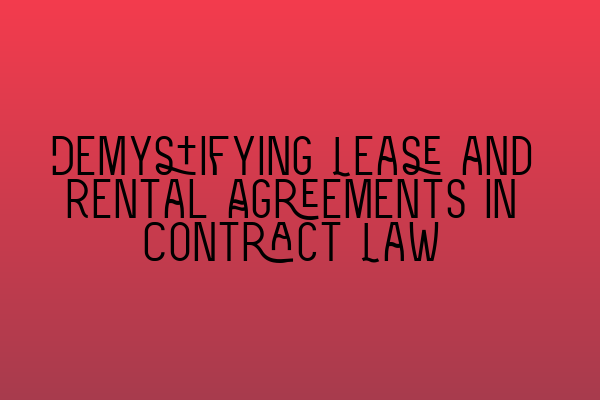Demystifying Lease and Rental Agreements in Contract Law
Lease and rental agreements are crucial elements in the field of contract law. Whether you are a landlord or tenant, understanding the intricacies of these agreements is essential to protect your rights and interests. In this blog post, we aim to demystify lease and rental agreements by providing you with insights into their key features, legal implications, and best practices. So, let’s dive in!
The Basics: What are Lease and Rental Agreements?
A lease agreement is a legally binding contract between a landlord and tenant, outlining the terms and conditions under which the tenant is granted the right to occupy a property for a specific duration of time. Rental agreements, on the other hand, are typically shorter in duration and often renewable on a monthly or weekly basis.
Lease and rental agreements serve as comprehensive documents that establish the rights and obligations of both parties involved. These agreements outline crucial details such as rent amount, payment terms, maintenance responsibilities, duration of the agreement, and conditions for termination.
Key Features and Elements
1. Rent Amount and Payment Terms
The rent amount and payment terms are essential aspects of any lease or rental agreement. It is crucial for the agreement to clearly state the rent amount, due date, and acceptable payment methods. Additionally, the agreement should specify any late fees or penalties for missed or delayed payments.
2. Duration and Termination
The lease or rental agreement should clearly indicate the duration of occupancy. For lease agreements, this typically ranges from six months to a year or even longer. Rental agreements, on the other hand, may be open-ended or for a specific duration, subject to renewal. Furthermore, the agreement should outline the conditions and notice required for termination by either party.
3. Maintenance and Repairs
Responsibilities for property maintenance and repairs must be clearly defined in the agreement. Typically, landlords are responsible for major repairs and structural maintenance, while tenants are responsible for everyday maintenance and minor repairs. It is advisable to include explicit clauses regarding the tenant’s obligation to keep the property clean and report any damages promptly.
4. Security Deposits
Lease and rental agreements often require tenants to provide a security deposit as a form of financial protection for the landlord. The agreement should specify the security deposit amount, the conditions under which it can be withheld, and the timelines for its return after the tenancy ends.
5. Prohibited Activities and Use of Property
It is common for lease and rental agreements to outline activities that are prohibited on the property. This may include restrictions on subletting, owning pets, conducting businesses, or engaging in illegal activities. Clearly defining these restrictions helps to protect the interests of both parties involved.
Legal Implications and Best Practices
1. Seek Legal Advice
When entering into a lease or rental agreement, it is always advisable to seek legal advice to gain a better understanding of your rights and obligations. An experienced solicitor can review the agreement, highlight any potential issues, and ensure it aligns with relevant laws and regulations.
2. Thoroughly Read and Understand the Agreement
Before signing any lease or rental agreement, take the time to thoroughly read and understand all its terms and conditions. Clarify any doubts or questions you may have and seek clarification from the landlord or legal professional if needed. Remember, signing an agreement binds you to its terms, so it is important to be fully aware of what you are agreeing to.
3. Maintain Communication
Clear and open communication between landlords and tenants is crucial for a smooth tenancy. If any issues or disputes arise during the occupancy, it is important to address them promptly and resolve them through constructive dialogue. Maintaining open lines of communication helps to minimize conflicts and ensures a mutually beneficial relationship.
4. Document Everything
It is wise to document all correspondence, agreements, and notices exchanged between the landlord and tenant. This may include rent payment receipts, repair requests, inspection reports, and any other relevant communication. Having a paper trail can provide clarity and evidence if any disputes arise in the future.
By incorporating these best practices, both landlords and tenants can minimize the risk of disputes and ensure a positive and legally compliant tenancy.
Conclusion
Lease and rental agreements play a vital role in the world of contract law. Understanding their key features, legal implications, and following best practices are essential for landlords and tenants alike. By demystifying lease and rental agreements, we hope to empower you with the knowledge to navigate these contracts with confidence.
For further insights into contract law, we recommend reading our related articles:
- Exploring the Impact of Frustration on Contractual Obligations: Legal Insights
- Interpreting Contractual Clauses: Unlocking the Hidden Meanings
- Legal Aspects of Business Contracts: Key Considerations for Entrepreneurs
- Agreements in Contract Law: Understanding Its Various Types
- Essentials of Consideration: Understanding the Basis of Contractual Exchange
